Table of content
Sales prospecting strategies have changed in 2025.
In 2025, it's less about "spray and pray" and more about aiming with intent, timing it right, and not sounding robotic. Buyers are sharper. Inboxes are crowded. And those generic messages? They get deleted faster than you can say "just checking in."
The old tactics still work, but only when you combine them with smarter, more personal strategies.
This guide breaks down 18 sales prospecting techniques that actually deliver results today. Some are classic plays with a fresh angle. Others are built for modern GTM teams that rely on data, timing, and thoughtful outreach.
No fluff. Just practical strategies to help you start better conversations and book more meetings.
Let’s dive in.
18 Sales Prospecting Strategies to Win in 2025
These are the most effective sales prospecting strategies to use in 2025.
1. Use Modern Prospecting Tools Like SMARTe
Smart sales prospecting starts with clean, accurate data. In 2025, the best teams use tools to find and reach the right people fast.
Sales intelligence platforms like SMARTe help you:
- Build prospect lists by industry, revenue, and team size
- Find key decision-makers using job title and seniority filters
- Access 281M+ verified B2B contacts and 65M+ companies
- Get 70%+ mobile number coverage in North America and strong reach across EMEA, LATAM, and APAC
- Reach global buyers with fresh, compliant data
With SMARTe, you don’t waste time on wrong numbers or bad leads. You get straight to the right contact and start real conversations.
Modern prospecting is not about volume. It’s about accuracy. Sales prospecting tools like SMARTe help you find the right accounts. You spend less time guessing. You close more deals.
2. Real-Time Intent Signal Prospecting
Catch the buyer at the moment of interest. That’s the key to a higher conversion rate.
Use intent data platforms like Bombora. These tools reveal which companies are:
- Actively searching for your product category
- Visiting your website or pricing page
- Reading reviews or comparing competitors
When you see the signal, act fast. Send a message. Make the call. Book the demo.
Why this works: You’re not interrupting. You’re responding. Buyers are already in research mode, and you meet them where they are. This sales prospecting technique is now core to every high-performing B2B sales team.
3. AI-Powered Data Enrichment and Personalization
No matter how good your outreach is, it fails without clean, complete data. That’s where AI-driven B2B data enrichment tools come in.
Platforms like SMARTe offer:
- Validated business emails and mobile numbers
- Updated job titles and roles
- Company firmographics and technographics
- Buyer intent signals and engagement data
Before your first touchpoint, enrich your CRM records. Add missing fields. Clean up bad data. This helps your SDRs avoid wasting time on dead leads.
But data enrichment alone isn’t enough. Use that data to personalize your prospecting. Reference their tech stack. Mention recent company news. Address pain points relevant to their role.
Why this matters in 2025: Personalization isn’t a nice-to-have—it’s a requirement. Generic cold emails go to spam. Targeted, enriched outreach starts real conversations.
4. Multi-Touch, Multi-Channel Sequences
One message is easy to ignore. That’s why top sales prospecting strategies in 2025 rely on sequences—smart, timely, and spread across channels.
Here’s what works:
- Cold emails with relevant subject lines
- LinkedIn DMs with personalized context
- Follow-up phone calls for human touch
- Retargeting ads to stay top-of-mind
- Short, personalized video for key accounts
Run 6 to 10 touches over 7 to 14 days. Use tools like Outreach.io to automate this sequence without losing human feeling.
Why it works: Each prospect checks different channels at different times. Repetition builds trust. A single message may go unnoticed, but a smart sequence breaks through.
This is one of the most proven sales prospecting methods today—especially for B2B teams targeting mid-market or enterprise accounts.
5. LinkedIn + Dark Social Engagement
LinkedIn prospecting in 2025 is not about cold outreach. It’s about building presence before pitching.
Start by engaging:
- Like and comment on your prospect’s content
- Share posts that speak to their role or pain points
- Post your own insights to build credibility
This creates a warm path for future outreach. When you DM later, you’re not a stranger—you’re a familiar voice.
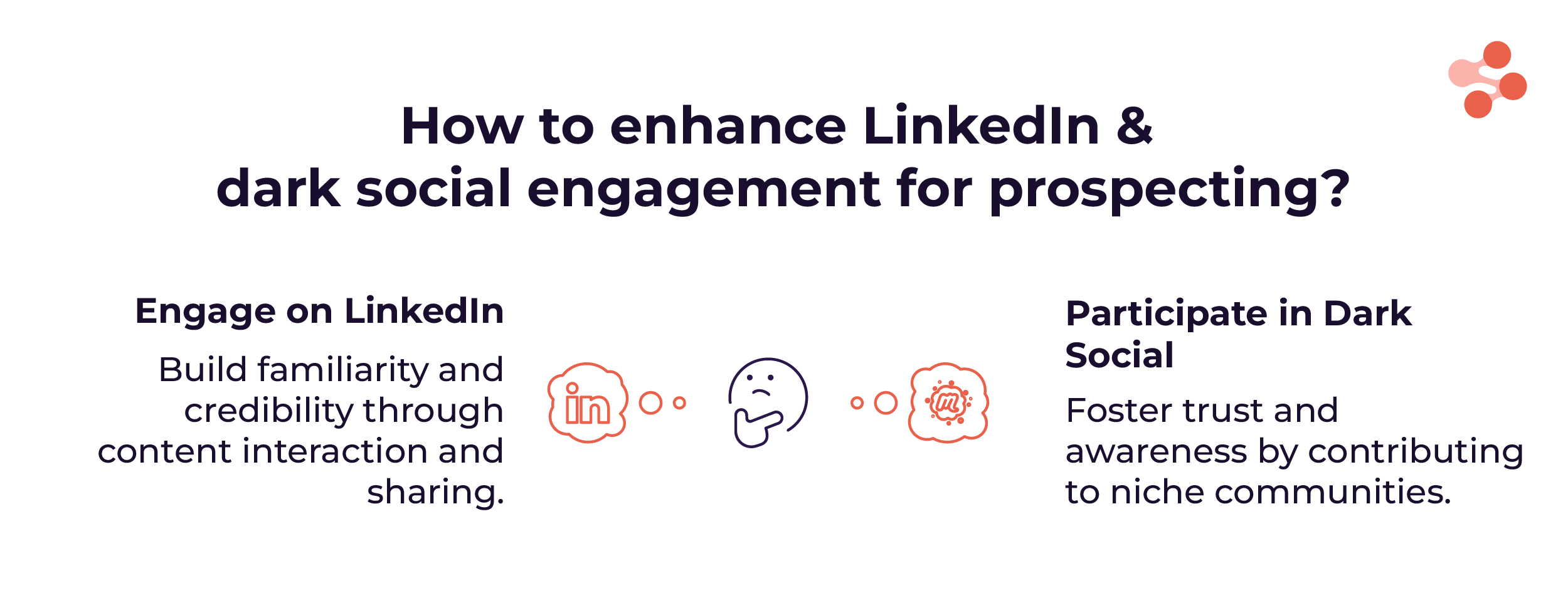
Don’t stop at LinkedIn. Many B2B buyers hang out in dark social spaces:
- Slack communities
- Discord groups
- Reddit threads
- Private WhatsApp or Telegram chats
- Niche forums in your industry
You won’t track clicks here. But you can build trust and awareness by being part of the conversation. Answer questions. Share real tips. Avoid hard sells.
This is one of the most underrated modern prospecting strategies—and the payoff is long-term brand lift and inbound leads.
6. Programmatic Warm-Up Before OutreachCold email in 2025 still works—but only if it feels tailor-made.
Outreach works better when your face or brand feels familiar. That’s why programmatic warm-up is now a go-to sales prospecting strategy for B2B teams in 2025.
Here’s how to do it:
- Run LinkedIn video ads targeting key accounts
- Use display retargeting to reach site visitors
- Promote short YouTube clips or testimonials
Do this for 7 to 10 days before sending any cold message. When the prospect sees your name in the inbox, it clicks—they’ve seen you before.
Why this matters: Cold outreach becomes warm prospecting. Trust builds faster. Reply rates rise. And you get fewer “not interested” responses.
Tools like Metadata.io, RollWorks, or LinkedIn Campaign Manager make this easy to scale.
7. Cold Email with Deep Personalization
Cold email in 2025 still works—but only if it feels tailor-made.
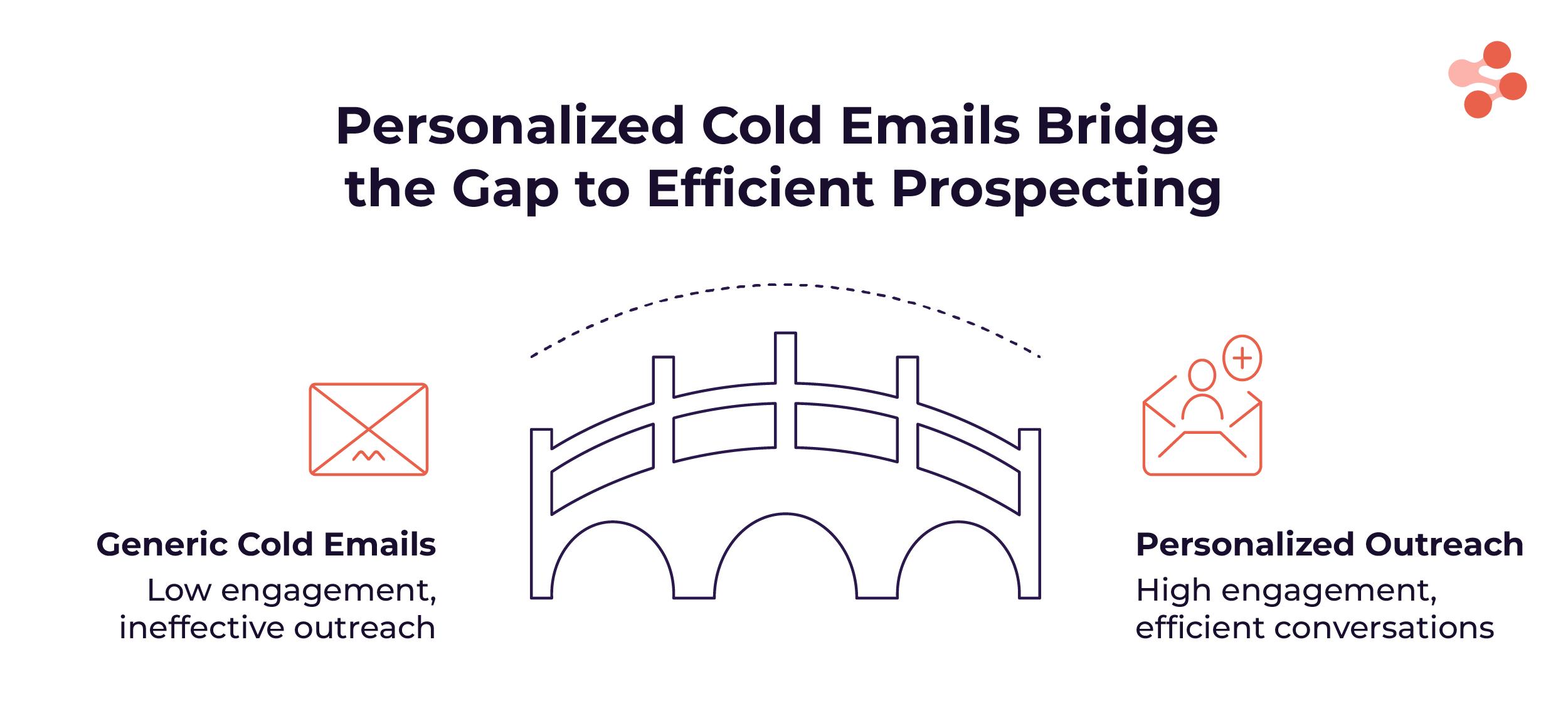
Forget the one-size-fits-all templates. Use AI data enrichment and intent signals to write messages that feel personal and timely.
Reference:
- Their role and what they care about
- Company milestones (funding, hiring, product launch)
- Tech tools they recently adopted or replaced
Then keep it tight:
- 2 to 3 short lines
- One clear CTA (book a call, reply, download)
- Real value in the first sentence
Example:
"Saw you're hiring 10 SDRs. We help teams cut ramp time by 30%—worth a quick chat?"
Why this works: It reads like a helpful note, not a sales pitch. And when done right, cold email prospecting becomes one of the most efficient ways to start conversations at scale.
8. Personalized Video Prospecting
Prospects are flooded with generic messages. Most go unread. Personalized video breaks through.
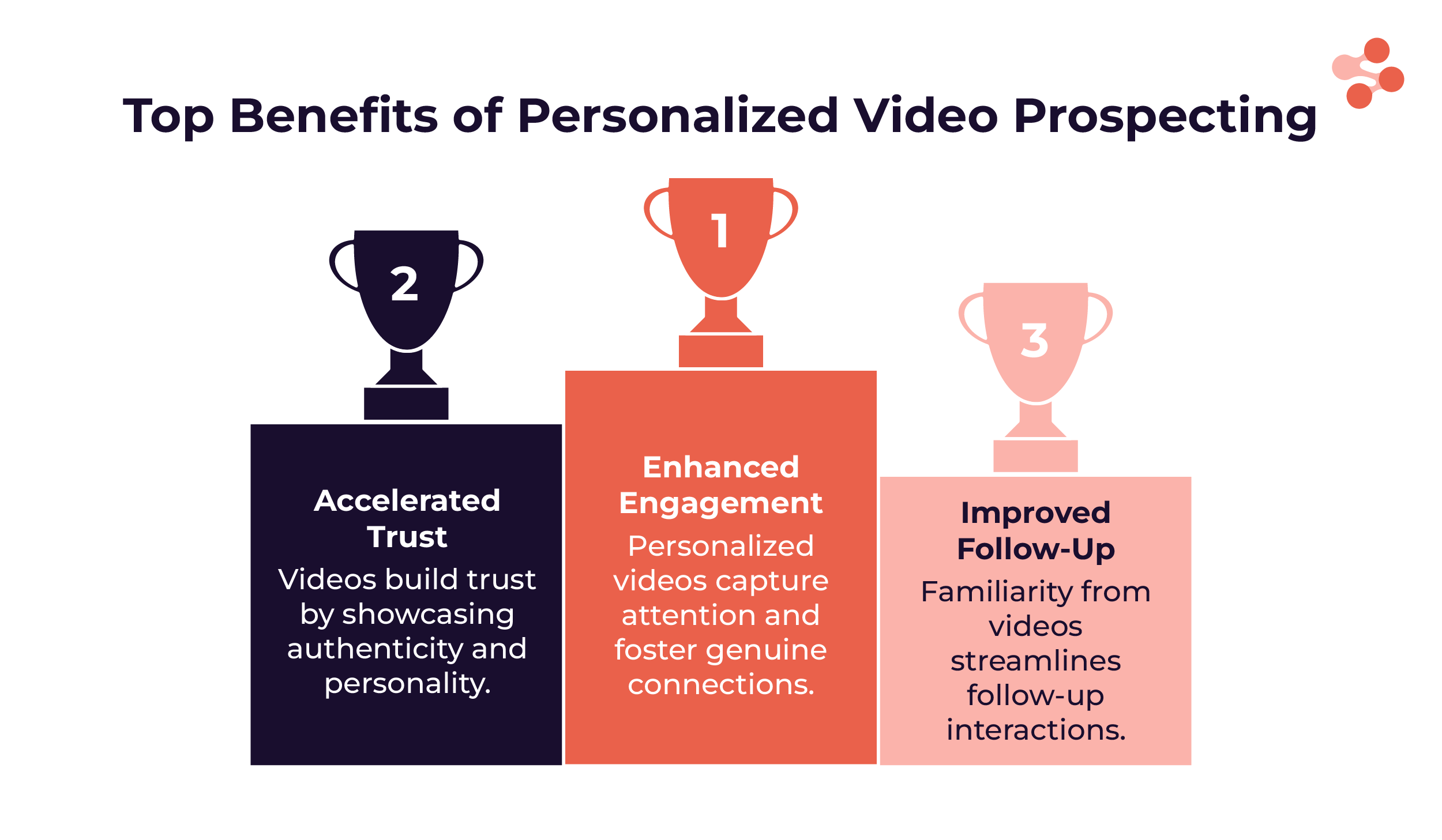
This strategy adds a human layer to your outreach. It shows effort and signals intent. You're not blasting a list—you’re speaking to one person.
Start simple:
- Greet them by name
- Mention a real challenge or milestone they care about
- Ask a relevant, low-friction question
Keep the video under 30 seconds. Be direct, clear, and real.
Example:
“Hi Alex, saw your team is expanding into EMEA. If your reps need cleaner B2B data to hit pipeline targets, happy to share what’s worked for others.”
The goal isn’t to impress—it’s to start a conversation.
Why this works: Video creates familiarity. It shows tone, energy, and authenticity that static emails lack. When you follow up, they already know your face and voice. That makes trust come faster.
Use this method for high-value accounts or unresponsive leads. It’s not for mass outreach. It’s for moments that need real connection.
9. Account-Based Social Prospecting
B2B Prospecting isn’t just outreach—it’s presence. And presence, when targeted, builds leverage.
Account-based social prospecting focuses on high-value accounts with a strategy built around visibility, relevance, and timing.
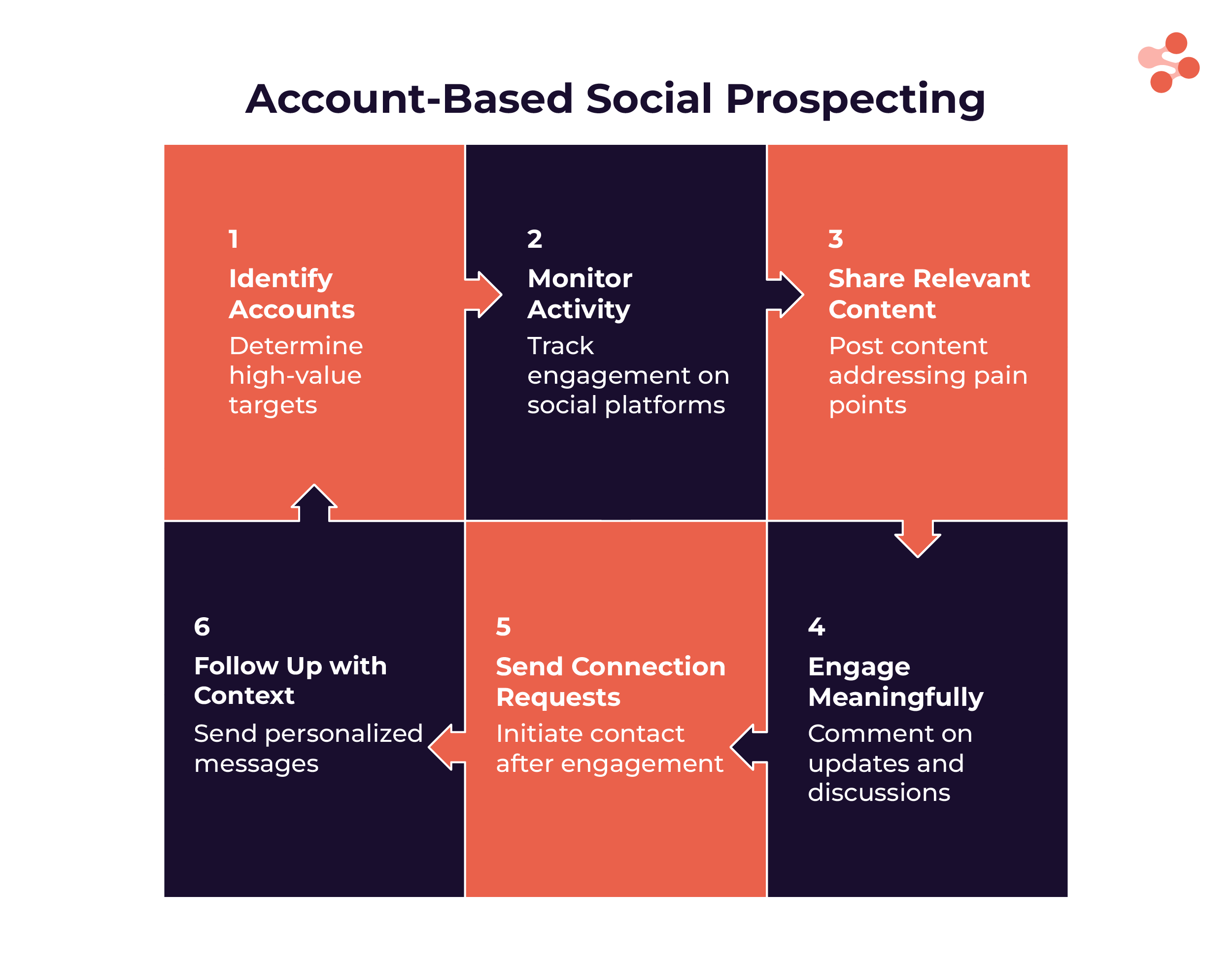
You’re not just showing up in their inbox. You’re showing up in their feed, in their industry conversations, and eventually, in their calendar.
Here’s the approach:
- Identify your top accounts and key decision-makers
- Monitor their activity across LinkedIn and relevant communities
- Share posts that speak directly to their pain points
- Comment meaningfully on their updates
- Send connection requests after you’ve engaged
Once the ground is warm, follow up with context-rich messages—not cold pitches. Reference what they’ve seen, shared, or commented on. Make it obvious that you’ve done your homework.
Why it works: This method earns attention before asking for time. It builds familiarity through content and interaction—not just cadence.
It also gives you soft signals. Likes, comments, or views tell you when interest is building—before a reply ever comes. That insight helps you time your outreach perfectly.
This strategy takes more work than a cold list—but the results justify it. Quality always beats quantity when it comes to prospecting real buyers.
10. Cold Calling with Timing, Triggers, and Smart Data
Cold calling is not dead. It’s evolving. In 2025, it still drives results—when done with the right strategy.
Start by warming up your prospect. Send a short email or connect on LinkedIn first. Then, call. When they’ve seen your name before, they’re more likely to pick up.
Timing matters. The best times to cold call are early mornings (8–10 AM) or late afternoons (4–6 PM), when people are between meetings.
Don’t just dial randomly. Use clear triggers like:
- “Congrats on the new funding!”
- “Noticed you moved to HubSpot—curious how onboarding is going.”
- “Saw you’re hiring new AEs. We’ve helped similar teams scale fast.”
These triggers show you’ve done your homework. That builds instant credibility.
Use a tight script. Lead with relevance. Keep it short. Focus on one problem you solve. End with a simple CTA like:
“Worth a quick call next week?”
Be ready for objections. Common ones include “Not interested,” “Busy right now,” or “Send more info.” Don’t panic. Acknowledge, ask a follow-up, and guide them back to value.
And yes—cold calling is legal, even in regions with GDPR or privacy laws. Just make sure you're calling business contacts with a valid interest and always offer an easy opt-out.
The biggest blocker in cold calling today? Bad data. Wrong numbers. Dead lines.
That’s why tools like SMARTe are key. With 70%+ mobile number coverage in North America and strong global reach, SMARTe helps reps bypass gatekeepers and connect faster—by phone or even by text.
In short:
- Call with purpose
- Time it right
- Use strong data
- Lead with insight
That’s how modern cold calling works—and wins.
11. Reverse Demo Strategy
Traditional demos start with a long setup. In 2025, that’s too slow.
Flip the script. Record a 60-second demo solving a common pain point for your ideal customer. Show, don’t tell. Skip intros. No filler. Just value.
Here’s how:
- Pick a problem they care about
- Show the fix
- End with: “Want us to do this for your team?”
Host the video on a simple page. Share it via email or DM. Let the product speak first—before you ask for a meeting.
This works because buyers now self-educate. If they see value early, they’re more likely to respond. The message is: “We get your problem, and here’s proof.”
Reverse demos work best when targeted. Use them for accounts showing buying intent or engagement.
12. Co-Sell and Nearbound Prospecting
You don’t need to prospect alone. The fastest path to trust is through someone the buyer already knows.
That’s the power of nearbound sales and co-selling.
Team up with people already close to your ideal customer:
- Agencies serving the same vertical
- Tech vendors with complementary tools
- Consultants solving related problems
- VCs connected to growing startups
Work together to:
- Co-host educational webinars
- Publish joint case studies
- Share warm intros or referral leads
Why it works: You enter through a door already open. There’s trust built in. Buyers listen when a known voice vouches for you.
This prospecting method takes time to set up—but it delivers higher reply rates, shorter sales cycles, and better-qualified deals.
13. AI SDR Assistants
AI isn’t replacing sales—it’s improving reach. Smart teams now use AI SDRs to handle the first touch.
AI bots—across chat, email, or voice—can:
- Answer FAQs
- Qualify basic inbound leads
- Route hot prospects to human reps
- Book meetings automatically
The key is training them well. Feed your AI with real sales conversations, CRM data, objections, and pitch lines. Over time, they get sharper.
This strategy works best for high-volume pipelines. It expands coverage without increasing headcount. And it frees up reps to focus on complex deals, not low-level filtering.
14. Thought Leadership as Prospecting Fuel
Prospects Google you before they respond. What they find shapes their first impression.
That’s why thought leadership is no longer optional—it's part of your prospecting engine.
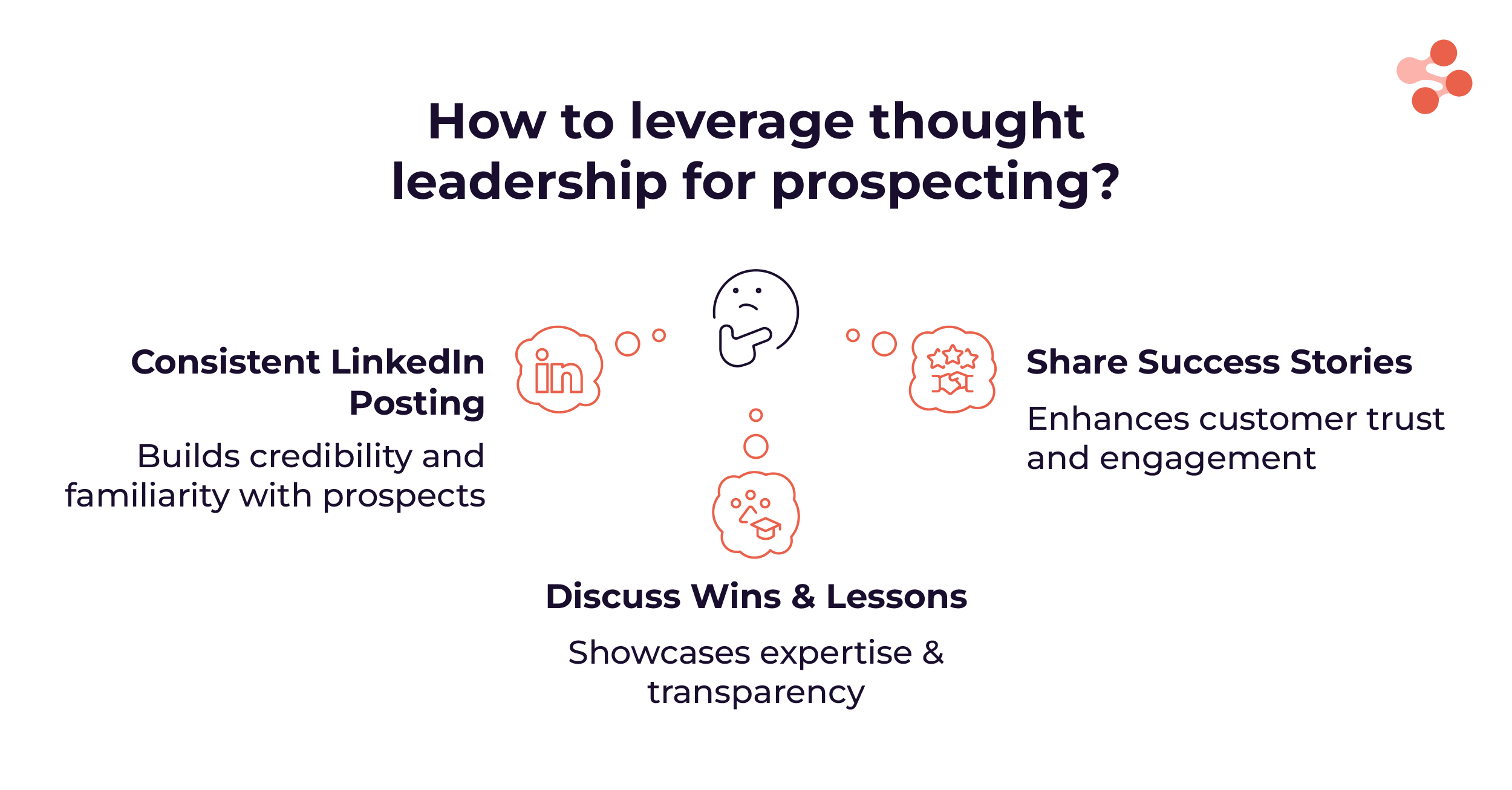
Here’s how to use it right:
- Post consistently on LinkedIn
- Share short takes on recent wins, lessons, or failures
- Talk about customer success—not just product features
Over time, this builds credibility. When your name lands in someone’s inbox, they remember your content. The outreach feels warmer—even familiar.
This doesn’t replace outbound. It amplifies it. Thought leadership works silently in the background, warming the soil before you plant the seed.
15. Intent-Qualified Lead Handoff
Not every lead is ready. Great sales teams work with marketing to score and route leads based on buyer intent.
Track signals like:
- Page visits to pricing or case study pages
- Ad clicks showing product interest
- Content downloads tied to problem awareness
Set thresholds. Only reach out when the signals show real buying behavior.
This keeps reps focused on real prospects—not dead-end leads. It also shortens the follow-up time between intent and outreach, which boosts reply and conversion rates.
Proper lead qualification based on intent leads to better pipeline health, more efficient sales cycles, and fewer wasted hours.
Also Read: Sales Prospecting vs Lead Generation
16. Job Change and Tech Trigger Outreach
Timing is everything in sales. One of the best prospecting strategies in 2025 is watching for role and tech stack changes.
When a buyer gets promoted, joins a new company, or switches tools, they’re in decision-making mode. They’re open to fresh solutions.
That’s your cue to reach out. Keep it short and focused:
“Congrats on the new role! If you’re planning to scale [team/function], happy to share what’s worked for others.”
Or:
“Saw you recently moved off [platform]. If you're exploring options, we’ve helped similar teams ramp fast.”
This isn’t about pitching. It’s about relevance. You’re connecting based on real change—not guessing. These moments create a natural entry point that feels timely, not intrusive.
17. Webinar and Event-Based Prospecting
Not all leads are equal. Some show up. Some engage. That’s why events are one of the most powerful sales prospecting methods—if you use them right.
Don’t think big conferences. Think focused:
- Invite-only roundtables
- Micro-webinars for niche roles
- AMAs that solve one specific problem
After the event, qualify by behavior. Who asked questions? Who stayed till the end?
Follow up with context:
“You mentioned [challenge] during the webinar—want to explore how others are solving it?”
Avoid “just checking in.” Lead with insight. Show that you listened. It turns an attendee into a real conversation.
18. Manual Prospecting (Still Works for High-Value Accounts)
In a world full of automation, manual prospecting still wins—especially for your top accounts.
For your top 10 targets, skip the automation. Instead:
- Dig into their LinkedIn activity
- Scan company news or blog posts
- Look at hiring trends and tech changes
Then write a message tailored only to them. Reference their world, not yours. Make it clear this isn’t a template.
Why it works: Decision-makers spot generic outreach a mile away. But they pause when it’s clear you’ve done the work.
Manual prospecting takes time—but for key accounts, it’s still one of the most effective strategies in your arsenal.
Final Thoughts
Sales prospecting in 2025 is about context, data, and timing.
The best sales prospecting techniques:
- Blend tech with a human touch
- Focus on signals, not just lists
- Win trust before the first call
Whether you're an SDR, AE, or founder, these prospecting methods will help you fill your pipeline with the right leads.









